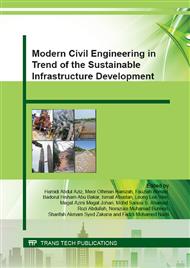[1]
M. N. Fardis, Innovative materials and techniques in concrete construction: ACES Workshop. Springer Dordrecht Heidelberg London New York: University of Patras, (2012).
Google Scholar
[2]
P. Richard, M. Cheyrezy, Composition of reactive powder concretes, Cem. Concr. Res. 25 (7) (1995) 1501-1511.
DOI: 10.1016/0008-8846(95)00144-2
Google Scholar
[3]
K. D. Hertz, Heat induced explosion of dense concretes. Report No. 166, Institute of Building Design, Technical University of Denmark, Lyngby, (1984).
Google Scholar
[4]
E. Worrel, L. Price, N. Martin, C. Hendricks and L. O. Meida, Carbon dioxide emissions from the global cement industry 1, Annu Rev Energy Env. 26 (1) (2001) 302-29.
Google Scholar
[5]
M. F. Arshad, Influence of multiple blended binders on engineering properties and durability of concrete Ph. D thesis, Universiti Sains Malaysia, Maaysia, (2010).
Google Scholar
[6]
S. Rukzon, P. Chindaprasirt, An experimental investigation of the carbonation of blended Portland cement palm oil fuel ash mortar in an indoor environment, Indoor Built Environ. 18 (4) (2009) 313-8.
DOI: 10.1177/1420326x09336554
Google Scholar
[7]
W. Tangchirapat, J. Tangpagasit, S. Waew-kum and C. Jaturapitakkul, A new pozzolanic material from palm oil fuel ash, KMUTT Res Dev J. 26 (4) (2003) 459-73.
Google Scholar
[8]
M. A. Megat Johari, A. M. Zeyad, N. Muhamad Bunnori and K. S. Ariffin, Engineering and transport properties of high-strength green concrete containing high volume of ultrafine palm oil fuel ash, Constr Build Master. 30 (2012) 281-8.
DOI: 10.1016/j.conbuildmat.2011.12.007
Google Scholar
[9]
M. A. A. Aldahdooh, Development of green ultra-high performance fiber reinforced concrete containing ultrafine palm oil fuel ash, Universiti Sains Malaysia, Malaysia, (2013).
DOI: 10.1016/j.conbuildmat.2013.07.007
Google Scholar
[10]
J. Wall, and N. Shrive, Factors affecting bond between new and old concrete, ACI Materials Journal. 85 (1998) 117-125.
Google Scholar
[11]
Y. S. Yuan, M. Marosszeky, Major factor influence the performance of structural repair, Evaluation and rehabilitation of concrete structures and innovations in design, Proceedings of ACI international conference, Hong Kong, (1991).
Google Scholar
[12]
A. Momayez, M. R. Ehsani, A. A. Ramezanianpour and H. Rajaie, Comparison of methods for evaluating bond strength between concrete substrate and repair materials, Cement and concrete research. 35 (2005) 748-757.
DOI: 10.1016/j.cemconres.2004.05.027
Google Scholar
[13]
Thesis, M. D. (2010). Evaluation of Bond Strength between Overlay and Substrate in Concrete Repairs.
Google Scholar
[14]
S. Austin, P. Robins, and Y. Pan, Shear Bond Testing of Concrete Repairs, Cement and Concrete Research, 29 (1995) 1067-1076.
DOI: 10.1016/s0008-8846(99)00088-5
Google Scholar
[15]
D. Cree, M. Green and A. Noumowé, Residual strength of concrete containing recycled materials after exposure to fire, A review. Construction and Building Materials. 45 (2003) 208–223. doi: 10. 1016/j. conbuildmat. 2013. 04. 005.
DOI: 10.1016/j.conbuildmat.2013.04.005
Google Scholar
[16]
S. Y. N. Chan, G. F. Peng and M. Anson, Fire behaviour of high-performance concrete made with silica fume at various moisture contents. ACI Mater J. 96 (3) (1999) 405-9.
DOI: 10.14359/640
Google Scholar
[17]
J. Xiao, H. Falkner, On residual strength of high-performance concrete with and without polypropelene fibres at elevated temperatures. Fire Safety J. 41 (2006) 115-21.
DOI: 10.1016/j.firesaf.2005.11.004
Google Scholar
[18]
D. N . Crook, M. J. Murray, Regain of strength after firing of concrete, Magazine of Concrete Research. 22 (72) (1970) 149-154.
DOI: 10.1680/macr.1970.22.72.149
Google Scholar
[19]
A. Petzold, M. Rohrs, Concrete for high temperature, Maclaren and Sons Ltd., London. (1970) p.190.
Google Scholar


